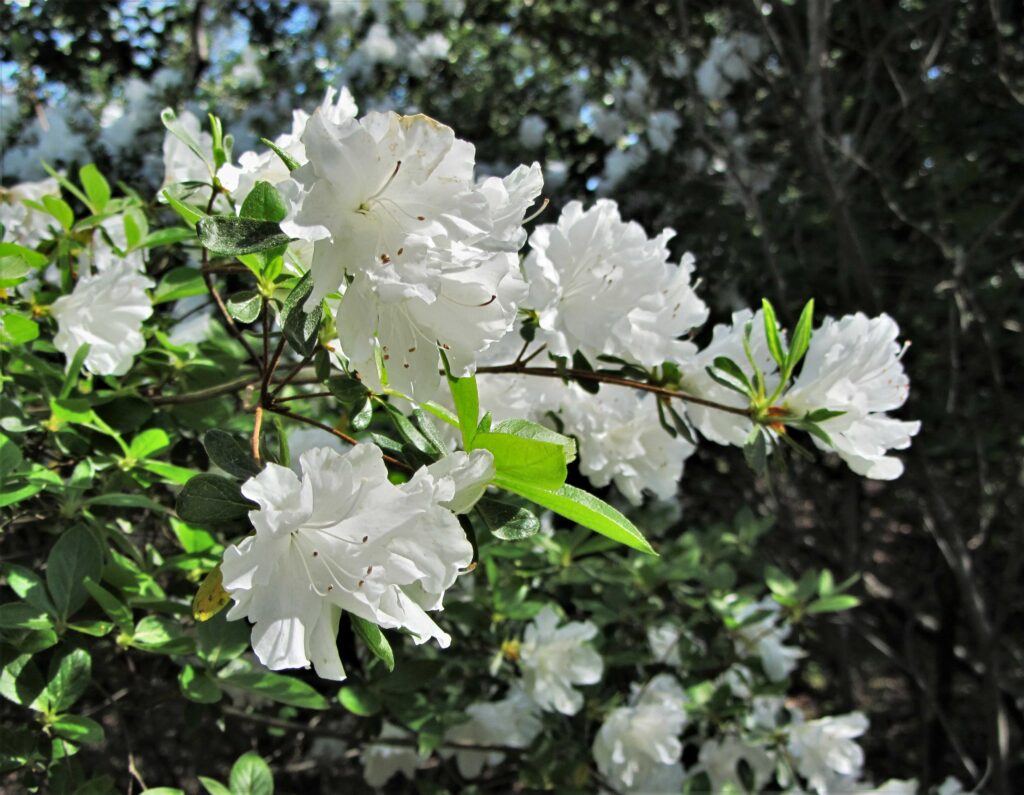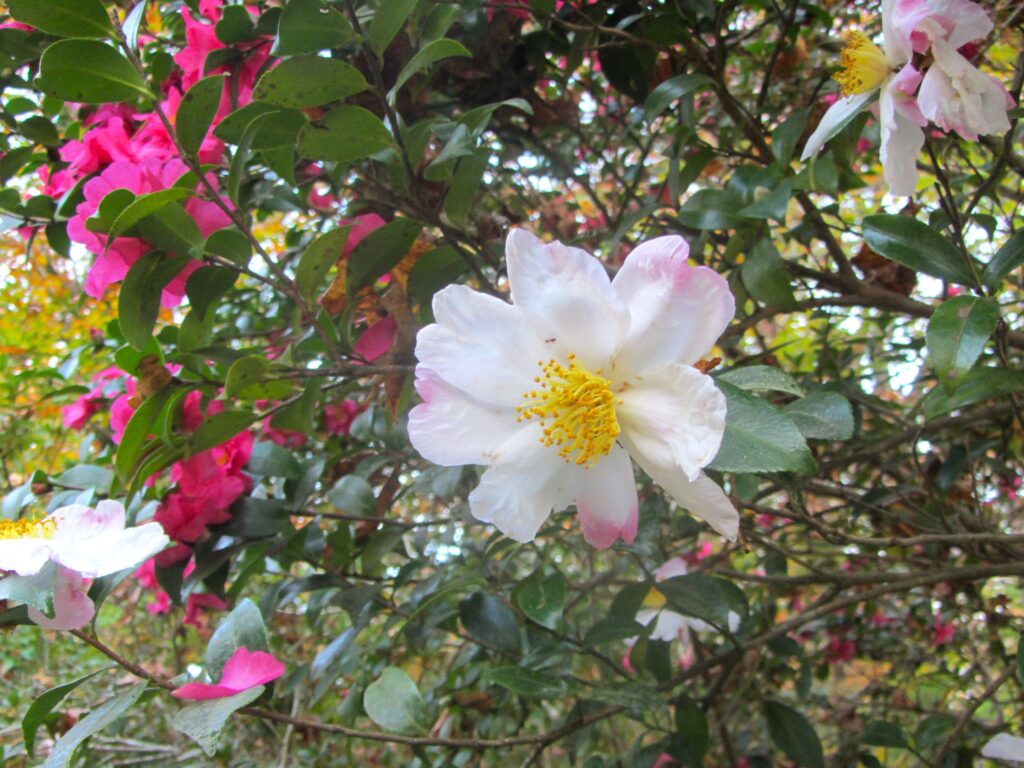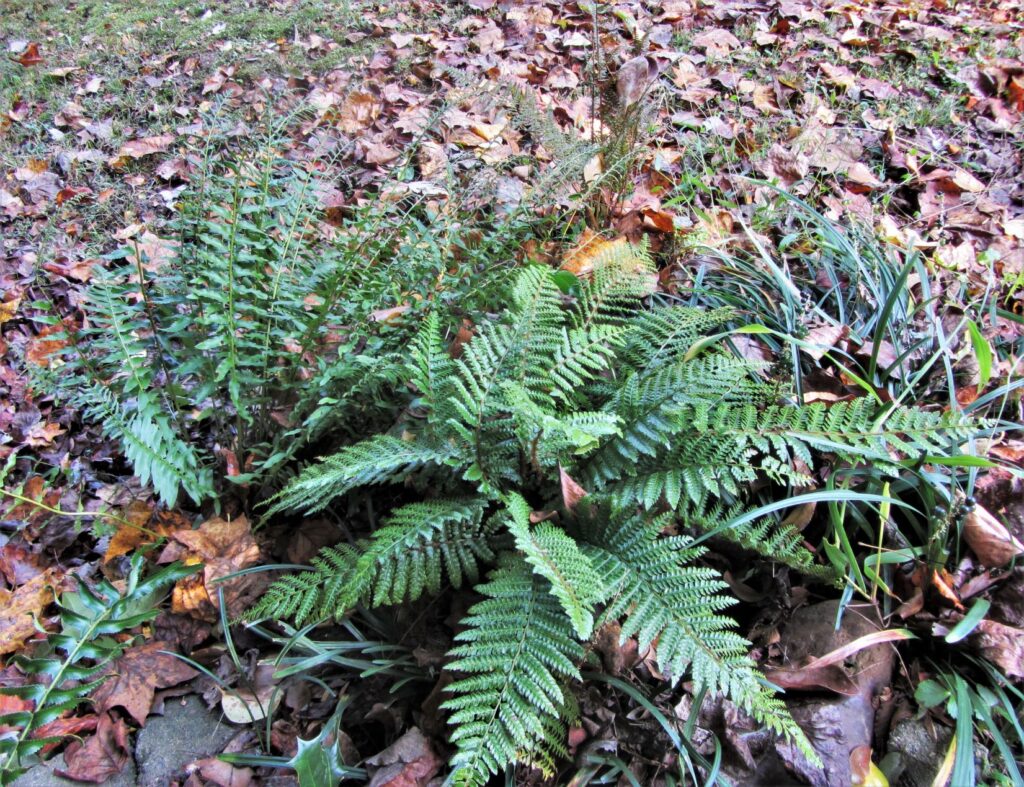Plant Literacy: Common Landscape Plants to Know and Love

All Rhododendron species, including hybrid Azaleas, perform well in bright shade. Although poisonous, deer often graze them.
Plant Literacy
Many people assume that Master Gardeners know a lot about plants. When neighbors request a home visit from the Landscape Love or Tree Call team, they often have three questions about certain plants in their yard: First, “What is it?” Some will follow up with, “Is it a native plant?” And then finally, “Will deer eat it?” If the homeowner already knows that deer will eat certain plants, then they may ask for advice about how to either protect the plant or replace it with something that deer won’t eat. If the plant isn’t thriving, or appears to have a disease or infestation, then the homeowner is hoping for a solution to their plant’s problems. One must be able to first identify the plant to give good advice for solving its problems.
Building Knowledge with Confidence
When folks consider whether or not to enroll in the Master Gardener training course, they may feel a little nervous about having to learn the names of unfamiliar plants. Many will confide that they just aren’t good with Latin or can’t remember all those strange names. Quite honestly, knowing the botanical name for plants isn’t a requirement for Master Gardener certification, and some folks never do learn very many proper names for plants. Some will confidently point to an app on their phone that they rely upon to identify plants. Truth be told, those phone apps may or may not return accurate information for every query.
It takes many years of study and practice to build up the sort of encyclopedic knowledge that some clients assume that Master Gardener volunteers possess when they come on a call. Some come armed with reference books. Others have been working closely with plants and gardens long enough to know about the common plants found over and over again in our area. But new Master Gardeners are people who love gardening, enjoy plants, and probably already know many of the plants commonly used in home landscapes. Even when we don’t know all of the names at first, we recognize and know quite a bit about our local flora already.

Colocasia esculenta ‘Mojito’ may also be called ‘Mojito’ elephant ear
Common and Botanical Plant Names
But knowing the common name of plants won’t take you very far, partly because a common name might mean different plants to different people. ‘Elephant Ear’ can refer to perhaps four or five different genera within the Aroid family. And a particular plant may be known by several different common names, depending on your cultural background and native tongue. Binomial scientific names came into standardized use in the 18th century to assist gardeners and botanists around the world to communicate with one another, no matter their fluency in another’s language.
A plant’s binomial name consists of its genus and its species. A variety or cultivar name may be added. For example, Dryopteris erythrosora ‘Brilliance’ is one of my favorite ferns. Some people call it autumn fern, some just call it ‘Brilliance.’ The genus Dryopteris includes 300-400 hundred species, and 83 hybrids of wood or buckler ferns found worldwide in temperate and tropical zones. Dryopteris erythrosora, commonly carried in local nurseries and sometimes in the garden centers of large hardware stores, happens to be native to Asia. ‘Brilliance,’ its cultivar name, refers to its bright coppery red fiddleheads and young fronds that emerge in spring and again in the autumn. Yet most people couldn’t tell this Asian fern from a native North American Dryopteris fern just from the shape of its fronds. Dryopteris ferns have more traits in common than those characteristics that divide them into different species.

Q. palustris, pin oak, is a species of red oak common in our area. The lobes of red oaks end in a sharp point, while white oak species have rounded lobes on their leaves.
The Binomial Name: Genus and Species
Knowing a plant’s genus tells us many things about it. The various species often are very similar in their preferences and growth habits. For example, of the approximately 500 species of oaks in the genus Quercus, they all are woody plants that produce acorns. All are very beneficial to wildlife, and most want to grow in full sun to part shade. Some are evergreen and others are deciduous. But all are very important tree species within their environment. There are perhaps 30 species of oak and a few more hybrids common in our Eastern Deciduous Forest biome. But they don’t all grow near the coast. Some grow further to the north or south of Virginia. And, some non-native oak species may be planted in local landscapes.
Knowing a plant’s species, or its parents if it is a hybrid, can provide more information about the plant and its needs. It may tell you how it will perform in your yard, whether it will be hardy during a particularly cold winter, what its flowers will be like, or whether it can help you solve specific problems. A water oak, Q. nigra, will grow well in occasionally wet soils and is semi-evergreen in our area. Plant it near waterways and in areas that sometimes flood. A white oak, Q. alba, prefers drier soil, will grow taller and will live many decades longer. But if you can look at a tree and know that it is an oak, that may be all you truly need to know. Certain species are more vulnerable to certain microbial infections or insect infestations than other species within the same genus.
Unlocking the Secrets of Plant Species Names

Camellia sasanqua blooms from October through early winter, making autumn feel like a second spring. C. japonica blooms from December through mid-spring. Camellias are evergreen shrubs native to Asia.
Building a Repertoire of Known Plants
Anyone who loves plants, and certainly anyone who wants to become a Master Gardener volunteer, will find it useful to build a repertoire of knowledge about common plants that grow well in our area. No one expects you to be able to name and describe every single plant you encounter, but it is helpful to know a few. As Master Gardeners begin to specialize in working with trees, or edible plants, native plants, bulbs, or ornamental perennials, they naturally learn more plants within certain categories than they learn in others. Working with certain projects, such as our Learning Gardens, helps new Master Gardeners learn about a wide variety of plants. Visiting our several local arboreta and gardens where plants are labeled helps build a working knowledge of many different plants, particularly native plants not commonly found in nurseries.

Elaeagnus umbellata, Autumn olive, blooms in early spring, then produces fruit in autumn. It was once heavily promoted by mail-order nurseries and sold as an excellent shrub for reclaiming damaged land, preventing erosion and for attracting wildlife. As birds spread the seed, it has become highly invasive.
Understanding ‘Invasive’ Plants
All Master Gardeners should have a working knowledge of plants considered invasive. Each state maintains a list of invasive plants causing problems in that state. Sometime regions within a state will have their own local list. You will find that one species within a genus is classified as invasive while another is not, or is a native plant. It is good to know a few native, or at least non-invasive alternatives for common invasive plants.
Invasive plants receive that label because they are imported plants that are causing a problem. Some, like Japanese stilt grass came accidentally as packing material or clinging to ships. Others were imported intentionally to solve a problem and later became popular, resilient, attractive to wildlife, and persistent. They reproduce easily, their seeds usually carried afield by wildlife who eat their fruits. Now they have escaped cultivation and out-compete native plants. Older neighborhoods were originally landscaped in previous decades with plants like burning bush or Japanese privet that now are considered invasive. Local garden centers may carry plants on the invasive list for sale because the demand for those plants remains strong. It can be helpful for Master Gardeners to know a few similar plants to offer as alternatives to common invasive ones.

Bald cypress, Taxodium distichum, is the only deciduous conifer. When it turns brown in autumn it isn’t dying, it is preparing for winter. This is also an unusual conifer that can grow in wet soils and standing water.
Speaking the Language
Pronouncing Latinized botanical names can be tricky at first. There are many guides online to assist in learning the proper way to pronounce these new words. As in learning any new language, one soon comes to recognize syllables common to many different names. It is very helpful to also know one or more common names for plants frequently found in our area since homeowners may not know the proper botanical names for many plants growing in their yard.
Master gardeners will find it useful to know the names of common plants and some basic, additional information. It is helpful to know whether a plant is hardy in our zone 8a, whether it needs shade, full sun, or something in between, and whether it is thirsty or prefers drier soil. It is growing too hot in our area for some beloved conifers to grow well, so knowing the southern range of a plant is helpful, too.
Many common plants are poisonous if eaten. Poisonous plants, like daffodils and Lenten roses, won’t be grazed by deer or rabbits. It is useful to know which plants are poisonous, particularly if a household has curious pets. And it is also good to know which plants, either native or imported, spread aggressively by either seed or rhizome. Understanding how plants reproduce and spread is useful in deciding where to place new plants, how to space them, and how many to use.
New Master Gardeners shouldn’t be expected to know everything there is to know about our local landscapes and garden plants, but all Master Gardeners should have an idea of where to find the information they need. This guide is intended to help build a basic plant literacy so we can become familiar with plants common in our area and so better serve our community.
Deciduous Trees and Shrubs Every Master Gardener Should Know
Broadleaf Evergreen Trees and Shrubs Every Master Gardener Should Know
Conifers Every Master Gardener Should Know

Polystichum acrostichoides, Christmas fern, left and P. polyblepharum, Korean tassel fern, right, both belong to the genus Polystichum and have similar cultural needs.
Ferns Every Master Gardener Should Know
Ornamental Perennials Every Master Gardener Should Know
Landscape Grasses Every Master Gardener Should Know

Narcissus spp. and Arum italicum both are highly poisonous. The evergreen fern is Dryopteris erythrosora. Evergreen Italian Arum is now considered invasive in Virginia.
Herbs Every Master Gardener Should Know
Common Invasive Plants Every Master Gardener Should Know
Unlocking the Secrets of Plant Species Names

Bracken fern, Pteridium aquilinum, grows with native Iris versicolor at the Williamsburg Botanical Garden, 2018.
Learn more about plants native to our region, which may or may not be in commercial cultivation, here:
Native Plants for Southeast Virginia, Including the Hampton Roads Region
All photos by E. L. McCoy

